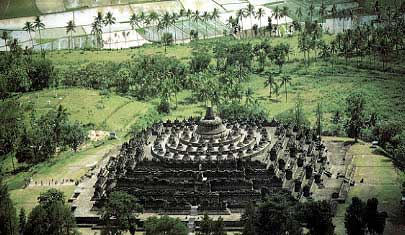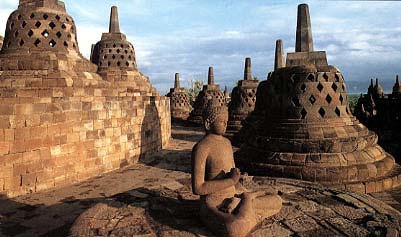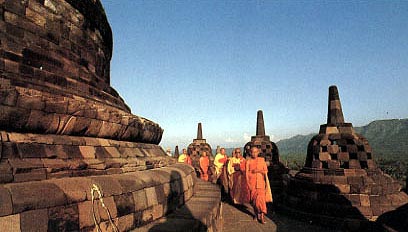A number of Buddhist and Hindu temple compounds are located approximately 40 km (25 miles) northwest of Yogyakarta, on an elevated area between two twin volcanoes, Sundoro-Sumbing and Merbabu-Merapi, and the Progo river. According to local myth, the area known as Kedu Plain is a Javanese 'sacred' place and has been dubbed 'the garden of Java' due to its high agricultural fertility. During the first restoration, it was discovered that three Buddhist temples in the region, Borobudur, Pawon and Mendut, are in one straight line position.[11] It might be accidental, but the temples' alignment is in conjunction with a native folk tale that a long time ago, there was a brick-paved road from Borobodur to Mendut with walls on both sides.
Unlike other temples, which are built on a flat surface, Borobudur was built on a bedrock hill, 265 m (869 ft) above sea level and 15 m (49 ft) above the floor of the dried-out paleolake. The lake's existence was the subject of intense discussion among archaeologists in the twentieth century; Borobudur was thought to have been built on a lake shore or even floated on a lake. In 1931, a Dutch artist and a scholar of Hindu and Buddhist architecture, W.O.J. Nieuwenkamp, developed a theory that Kedu Plain was once a lake and Borobudur initially represented a lotus flower floating on the lake. Lotus flowers are found in almost every Buddhist work of art, often serving as a throne for buddhas and base for stupas. The architecture of Borobudur itself suggests a lotus depiction, in which Buddha postures in Borobudur symbolize the Lotus Sutra, mostly found in many Mahayana Buddhism (a school of Buddhism widely spread in southeast and east Asia regions) texts. Three circular platforms on the top are also thought to represent a lotus leaf. Nieuwenkamp's theory, however, was contested by many archaeologists because the natural environment surrounding the monument is a dry land.
Geologists, on the other hand, support Nieuwenkamp's view, pointing out clay sediments found near the site.[13] A study of stratigraphy, sediment and pollen samples conducted in 2000 supports the existence of a paleolake environment near Borobudur, which corroborates the doubts had raised by archaeologists . The lake area, however, fluctuated with time; a study also proves that Borobudur was near the lake shore circa thirteenth and fourteenth century. River flows and volcanic activity have contributed to the landscape of the lake. One of the most active volcanoes in Indonesia, Mount Merapi, is in the direct vicinity of Borobudur and has been very active since the Pleistocene.
| Borobudur | |
 | |
| Building Information | |
|---|---|
| Name | Borobudur |
| Location | near Magelang, Central Java |
| Country | Indonesia |
| Architect | Gunadharma |
| Completion Date | circa AD 800 |
| Style | stupa and candi |



Buddhist marvel of stone standing in the garden of Java, Indonesia
The Borobodur Temple complex is one of the greatest monuments in the world. It is of uncertain age, but thought to have been built between the end of the seventh and beginning of the eighth century A.D. For about a century and a half it was the spiritual centre of Buddhism in Java, then it was lost until its rediscovery in the eighteenth century.
The structure, composed of 55,000 square meters of lava-rock is erected on a hill in the form of a stepped-pyramid of six rectangular storeys, three circular terraces and a central stupa forming the summit. The whole structure is in the form of a lotus, the sacred flower of Buddha.

One of the ninety-two Dhyani Buddha statues enclosed in stupas
For each direction there are ninety-two Dhyani Buddha statues and 1,460 relief scenes. The lowest level has 160 reliefs depicting cause and effect; the middle level contains various stories of the Buddha's life from the Jataka Tales; the highest level has no reliefs or decorations whatsoever but has a balcony, square in shape with round walls: a circle without beginning or end. Here is the place of the ninety-two Vajrasattvas or Dhyani Buddhas tucked into small stupas. Each of these statues has a mudra (hand gesture) indicating one of the five directions: east, with the mudra of calling the earth to witness; south, with the hand position of blessing; west, with the gesture of meditation; north, the mudra of fearlessness; and the centre with the gesture of teaching.

Devotional practice of circumambulate around the galleries and terraces.
Besides being the highest symbol of Buddhism, the Borobodur stupa is also a replica of the universe. It symbolises the micro-cosmos, which is divided into three levels, in which man's world of desire is influenced by negative impulses; the middle level, the world in which man has control of his negative impulses and uses his positive impulses; the highest level, in which the world of man is no longer bounded by physical and worldly ancient desire.
It is devotional practice to circumambulate around the galleries and terraces always turning to the left and keeping the edifice to the right while either chanting or meditating. In total, Borobodur represents the ten levels of a Bodhisattva's life which he or she must develop to become a Buddha or an awakened one.


0 Comments:
Post a Comment
Subscribe to Post Comments [Atom]
<< Home